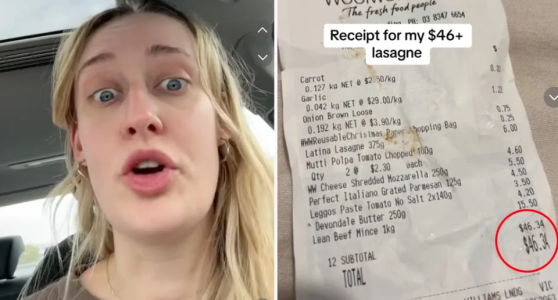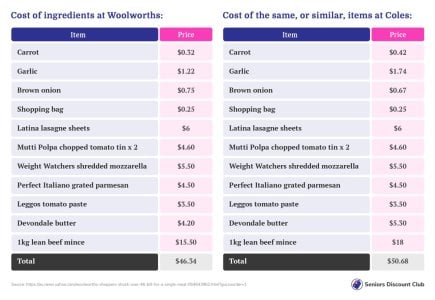Can you imagine a $46 bill for just one meal? This Woolworths shopper couldn’t either!
Rising grocery prices continue to strain the wallets of Australians, especially as we all try to save money in these uncertain times.
This was shown starkly when Australian shopper Nat decided to make a home-cooked meal in an attempt to save a few dollars.
To her shock, a small number of items that would contribute to a single lasagne meal amounted to nearly $50 at Woolworths!
In a video on social media, the shopper said: ‘I just spent $46 on lasagne ingredients, and I already had half the ingredients at home. $46 f***ing for lasange. Are you f***ing joking?’
'I should just eat Maccas every day', she continued, suggesting that McDonald’s could still be a more affordable choice for cash-strapped Aussies, even considering its high prices.
To back up her claim, Nat shared a photograph of her receipt that showed a clear breakdown of the cost involved in her $46 meal.
The shopper said she had only purchased items for the one dinner and hadn't bought anything extra.
Understandably, Aussies who are already struggling financially are feeling the impacts of the increase more heavily.
According to a survey early this year conducted by comparison and financial literacy website Finder, the average household already spent $199 per week on groceries alone, up from $184 per week in June 2022.
Around 78 per cent of respondents said they were looking for cheaper meals or discounts to cope with runaway inflation, and half admitted to feeling financially pressured over higher costs. Similarly, some Aussies said they were skipping some essential items like cereal or razor blades altogether.
In August, a mum who had compared 52 products from an online order in late 2022 to current prices at Coles pointed out that the same shop cost her $192.80 then compared to $226.24 now—an increase of $33.34 or 17 per cent.
While some might think high grocery prices incentivise patronage of fast food, fast food places have also seen their prices increase.
According to UBS analysis, price hikes of 8 per cent and 14.7 per cent for McDonald’s and KFC, respectively, had been observed since August.
So what can we do to try and offset the rising cost of food?
Switching to no-name brands is a good way to save money.
Many made this suggestion in response to Nat's video, noting that her purchase of branded items was a definite way to increase spending at the checkout.
While Nat responded that ditching branded products was 'not that much cheaper' with a difference of only a few dollars, viewers insisted that a few simple switches—such as swapping lean mince to regular mince—could still make a difference in her grocery bill.
Some also said that going for a ready-to-eat lasagne meal would have been a cheaper option, but she fired back by urging people not to compare a store-made product with a homemade meal.
‘This is wild. I tried to get ingredients for lunch at Coles the other day and realised it was cheaper to get a $15 meal at food court,’ another shared.
‘It is actually very true. Some restaurants are much cheaper than doing it yourself,’ agreed a second.
Nat’s story comes just as Coles and Woolworths were criticised for alleged ‘price gouging’ amid rising prices recently, with several shoppers increasingly feeling they were getting less at a higher price.
However, Coles defended its pricing, citing a $2.60 profit per $100 spent and business costs such as construction, energy, logistics, and packaging in a newly released statement.
Meanwhile, Woolworths reaffirmed its commitment to fair deals for shoppers, staff, and suppliers, acknowledging the strain on Australians from the rising cost of living.

Although supermarkets have previously shut down accusations of ‘price gouging’, it’s clear from Nat's experience—and countless others—that shoppers on a budget are feeling the effects of rising prices more deeply than ever.
Members, what do you think of this story? Share your thoughts in the comments below!
This was shown starkly when Australian shopper Nat decided to make a home-cooked meal in an attempt to save a few dollars.
To her shock, a small number of items that would contribute to a single lasagne meal amounted to nearly $50 at Woolworths!
In a video on social media, the shopper said: ‘I just spent $46 on lasagne ingredients, and I already had half the ingredients at home. $46 f***ing for lasange. Are you f***ing joking?’
'I should just eat Maccas every day', she continued, suggesting that McDonald’s could still be a more affordable choice for cash-strapped Aussies, even considering its high prices.
To back up her claim, Nat shared a photograph of her receipt that showed a clear breakdown of the cost involved in her $46 meal.
The shopper said she had only purchased items for the one dinner and hadn't bought anything extra.
Understandably, Aussies who are already struggling financially are feeling the impacts of the increase more heavily.
According to a survey early this year conducted by comparison and financial literacy website Finder, the average household already spent $199 per week on groceries alone, up from $184 per week in June 2022.
Around 78 per cent of respondents said they were looking for cheaper meals or discounts to cope with runaway inflation, and half admitted to feeling financially pressured over higher costs. Similarly, some Aussies said they were skipping some essential items like cereal or razor blades altogether.
In August, a mum who had compared 52 products from an online order in late 2022 to current prices at Coles pointed out that the same shop cost her $192.80 then compared to $226.24 now—an increase of $33.34 or 17 per cent.
While some might think high grocery prices incentivise patronage of fast food, fast food places have also seen their prices increase.
According to UBS analysis, price hikes of 8 per cent and 14.7 per cent for McDonald’s and KFC, respectively, had been observed since August.
So what can we do to try and offset the rising cost of food?
Switching to no-name brands is a good way to save money.
Many made this suggestion in response to Nat's video, noting that her purchase of branded items was a definite way to increase spending at the checkout.
While Nat responded that ditching branded products was 'not that much cheaper' with a difference of only a few dollars, viewers insisted that a few simple switches—such as swapping lean mince to regular mince—could still make a difference in her grocery bill.
Some also said that going for a ready-to-eat lasagne meal would have been a cheaper option, but she fired back by urging people not to compare a store-made product with a homemade meal.
‘This is wild. I tried to get ingredients for lunch at Coles the other day and realised it was cheaper to get a $15 meal at food court,’ another shared.
‘It is actually very true. Some restaurants are much cheaper than doing it yourself,’ agreed a second.
Nat’s story comes just as Coles and Woolworths were criticised for alleged ‘price gouging’ amid rising prices recently, with several shoppers increasingly feeling they were getting less at a higher price.
However, Coles defended its pricing, citing a $2.60 profit per $100 spent and business costs such as construction, energy, logistics, and packaging in a newly released statement.
Meanwhile, Woolworths reaffirmed its commitment to fair deals for shoppers, staff, and suppliers, acknowledging the strain on Australians from the rising cost of living.
Key Takeaways
- An Aussie shopper shocked over spending $46 on ingredients for a single lasagne meal at Woolworths.
- The shopper, a woman named Nat, posted a video and receipt of her grocery bill on social media, causing widespread discussion.
- The cost of groceries in Australia is a major concern, with supermarkets facing accusations of ‘price gouging’.
- Both Coles and Woolworths have defended their pricing, attributing higher costs to increased business expenses and cost-of-living increases.
Members, what do you think of this story? Share your thoughts in the comments below!









